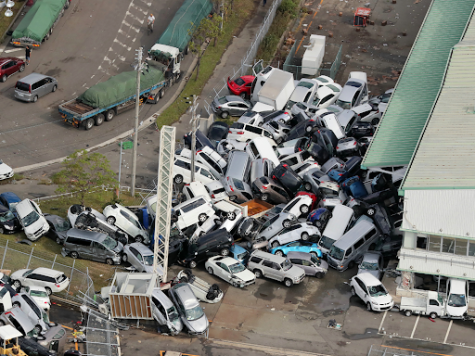
Japan: A Tempestuous Misfortune
Japan and other island nations around the world are facing some of the most severe impacts of climate change. With more extreme weather events on the rise, welfare is being threatened.
February 17, 2023
With countless traditions and cultural landmarks, Japan is one of the world’s leading economic and technological centers. The country has a beautiful and diverse history; however, recent headlines related to climate crises are causing a breakdown.
According to The Climate Reality Project, over 600 million people worldwide live in coastal areas less than 10 meters above sea level. This results in many countries constantly facing danger, with some being completely submerged underwater when typhoons or hurricanes strike.
Although Japan isn’t nearly in as much danger when compared to some other nations, it still faces similar impacts from rising seas. This has already caused serious destruction to coastal regions.

For example, in September 2018 Typhoon Jebi flooded Kansai International Airport, leaving thousands of people stranded. The tropical disturbance took 17 lives and created insured losses of over $14 billion.
A more recent weather crisis hit Japan late August of last year: Typhoon Hinnamnor, an abnormally large and powerful cyclone that killed 12 people. According to The New York Times, it was the Northern Hemisphere’s strongest tropical cyclone of 2022. Intense flooding and destructive wind gusts as high as 185 mph truly made the storm life threatening.
So, why exactly is climate change so detrimental to Japan and other island countries? As touched on before, rising sea levels and polar ice melting play a role. The complete answer, however, is much more complex.
Many studies have shown that climate change can negatively impact food security in Pacific islands, by threatening their fisheries and agriculture.
This is a big problem as resources become limited and infrastructure is damaged.
It’s clear that Japan is on an upward trend of rising sea levels damaging the economy. It’s reasonable to think that as time passes and the country advances, the issue of climate change would somewhat diminish, but sadly that’s not the case.

Luckily, there’s a silver lining beneath the dark cloud. Japan’s energy plan is on path to raising the percentage of electricity generated through renewable energy up from 18% in 2019 to between 36-38% by 2030. In addition, the country is committed to reducing greenhouse gas emissions by over 26% over the next decade. Japan’s prime minister once said the country is “determined to boldly adopt policies that have been politically difficult in the past, against the backdrop of the public’s sense of urgency to tackle climate change.”
Despite climate crises being unpredictable, there are plenty of steps we can take to mitigate the damage inflicted. “We are in danger of destroying ourselves by our greed and stupidity. We cannot remain looking inwards at ourselves on a small and increasingly polluted and overcrowded planet”. Stephen Hawking worded it perfectly: “We need to act promptly instead of ignoring reality.”
Recycling more or even changing to LED light bulbs are all effective starting point ways to mitigate climate change. Simple steps like this on a widespread basis works because in doing so it can lead to the reduction of tons of carbon dioxide ultimately leading to better air quality and ultimately saving lives.